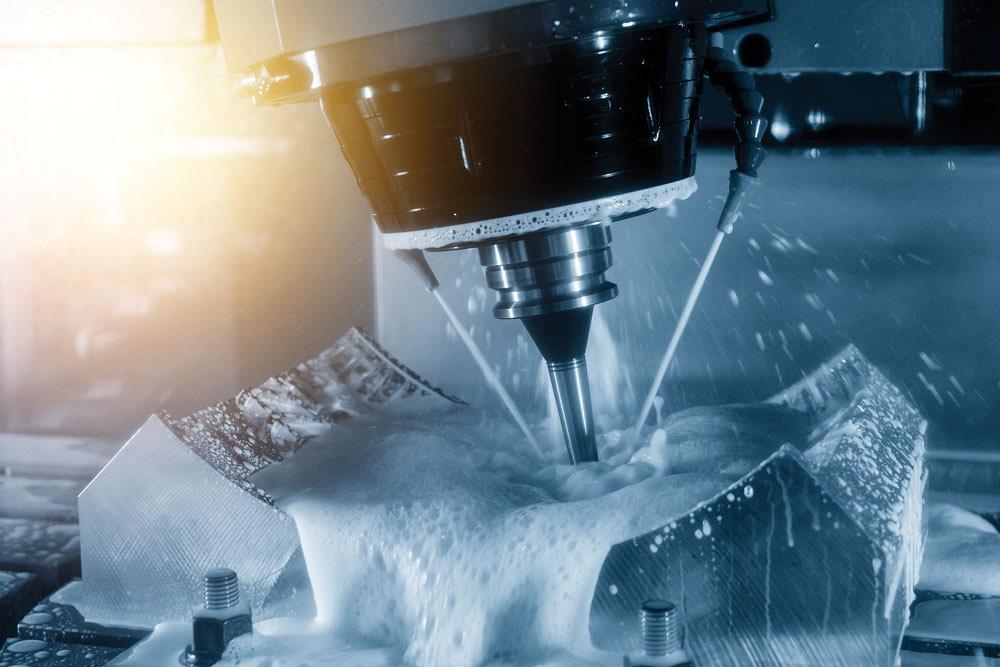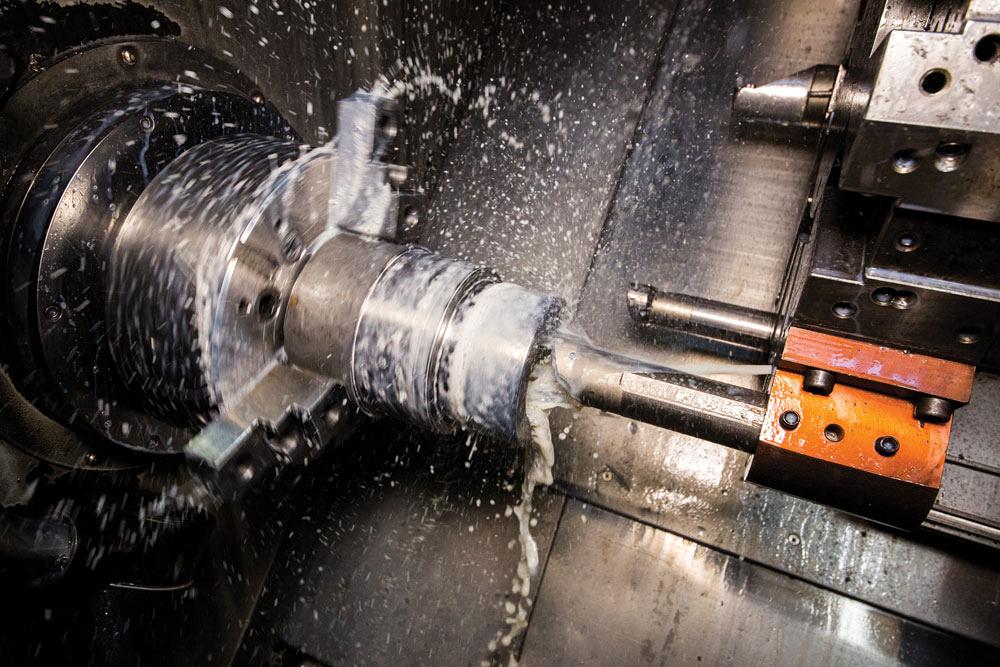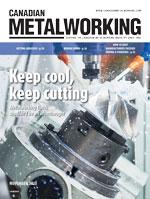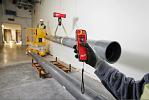Editor
- FMA
- The Fabricator
- FABTECH
- Canadian Metalworking
Keep cool, keep cutting
Metalworking fluids shouldn’t be an afterthought
- By Joe Thompson
- November 23, 2020
- Article
- Metalworking

The high hardness of HRSAs typically requires lighter cuts to be performed, so a cutting fluid with high lubricity is needed. Other materials need a combination of lubricity and cooling to work well.
The use of metalworking fluids is as old as metal cutting itself. They perform several tasks during cutting and should be given the same attention as the machine and cutting tool.
The eight primary functions of metalworking fluid are:
- Cooling the tool.
- Cooling the workpiece.
- Providing lubrication.
- Protecting against corrosion.
- Flushing chips away from the work area.
- Improving tool life.
- Reducing energy consumption and machining forces.
- Improving the surface finish of the part.
Additional factors to consider are operator health and safety (human compatibility) and product stability in the sump, which is an important maintenance issue. Fluids serve secondary purposes as well, such as protecting the machine and parts against corrosion and maintaining overall process stability.
Cooling is provided by water in the fluid’s formulation. However, water also enables rust formation, biological contamination (bacteria, fungus, mould), and has a hardness (dissolved minerals) that can affect the formulation. Therefore, water-based metalworking fluids also need to have rust and biological protection as well as hard water stability as key functions.
That’s a lot to ask, so it shouldn’t be an afterthought. As part of the overall production process, metalworking fluid accounts for roughly 1 per cent of total cost. However, its ability to lengthen tool life, reduce work hardening, and improve surface finish means that it’s not something that should be skimped on.
“Overlooking the importance of the metalworking fluid to the overall operation is a huge mistake. And can be a costly one,” explained Jennifer Lunn, senior chemist at JTM Products, Solon, Ohio. “The investment that a shop will spend on a machine is often well into the $100,000 to $500,000 range. In addition, set up time for a new machine can take days to weeks, and inserts for tools, although highly variable, often can range anywhere from $20 to $100.”
According to Lunn, if the proper metalworking fluid is not chosen and appropriate lubrication/cooling not provided, the number of tools or inserts per job will increase to the point where any savings realized by choosing a “cheap” metalworking fluid will be offset by new and more tooling costs.
“As tools and inserts wear out more quickly, downtime increases because operators will need to switch them out more often. This will lower productivity and decrease the total parts made in a set amount of time. If the fluid is dialed in to provide the appropriate amount of lubricity and cooling, downtime decreases, tool costs decrease, and productivity of the shop increases,” said Lunn.
Dialing in Fluids
When the material being cut is hardened steel, nickel alloys, or titanium, the choice of metalworking fluid can literally make or break an operation.
“Difficult-to-cut materials such as heat-resistant superalloys (HRSAs) and titanium create more heat during the machining process than carbon steel generates when being cut,” explained David Foster, district sales manager for Canada with Master Fluid Solutions, Perrysburg, Ohio. “Titanium is a poor conductor of heat, which means the heat generated during the cutting of this metal does not dissipate as quickly. Cooling becomes very important, and minimizing the dwell time of cutting tools is of the utmost importance due to the possibility of increased work hardening.”

When choosing any fluid, shops need to consider the application as well as the material being machined.
The poor conductivity of titanium, combined with high hardness levels, makes the cutting zone much hotter, especially at the tool/workpiece interface. To maintain dimensional stability and extend the life of the cutting tool, coolant volume needs to be greater in these operations than that used to machine the more common materials.
“Titanium is unique in that it is a harder material but very difficult to cut cleanly. The titanium alloy tends to ‘tear’ when machined,” explained Kevin Marquis, vice president of sales – metalworking division for JTM Products. “This then requires the fluid selected to have the correct amount of lubricity to minimize the tearing effect as it’s being machined.”
When you cut these materials, the best place for coolant to be is just before the cut, on the tool cutting edge, and on the tool's wear surface.
“A side effect of the excess heat is an increase in the rate of water evaporation, resulting in a higher concentration and a further reduction in cooling ability because of the lower volume,” said Jed DeJong, senior applications engineer for Blaser Swisslube, Goshen, N.Y. “Both neat oils and water-miscible fluids will react somewhat differently. Oils become thin and water-miscible coolants may foam, for example. Additives may be required for extreme high-pressure systems.”
While the ability to cool the work zone is important in titanium cutting, other difficult-to-cut metals have different requirements.
For example, the high hardness of HRSAs typically requires lighter cuts to be performed, so a cutting fluid with high lubricity is needed. Other materials need a combination of lubricity and cooling to work well.
“To reduce friction and wear, coolant technology may need to be formulated with extreme-pressure (EP) additives. These are molecules with chlorinated, sulphurized, or phosphated backbones. If these cannot be used, high-quality esters are used,” said Jeff Nowosad, product application manager -- Canada at Quaker Houghton, Waterloo, Ont.
According to Nowosad, reducing friction and wear has the added benefit of reducing energy consumption.
Metalworking fluids for specific applications should be chosen based on three criteria: compatibility, acceptability, and machinability.
Generally speaking, hard materials need greater cooling ability, while soft materials require higher lubricity. Also, an operation with high surface feet per minute (SFPM) needs more cooling, while low-SFPM operations run best with fluid that has high lubricity.

Metalworking fluids for specific applications should be chosen based on three criteria: compatibility, acceptability, and machinability.
“If a fluid is chosen for its lubricity characteristics, it must be directed to a point that will allow a film to form between the tool, the workpiece, and the chip, which is at the cutting edge of the tool,” said Foster. “Similarly, if a coolant is chosen for its cooling ability, it has to be directed to where cooling is required, the cutting edge of the tool.”
Get the Heat Out
Heat is generated at the point of cut and then approximately 80 per cent goes into the chip. More difficult-to-cut materials require formulations with higher amounts of water with the ability to flush the chips away from the work area.
“Mechanically, many modern metalworking machines are now equipped with high-pressure fluid delivery systems to flush the chips away faster. However, most metalworking fluids are made up of chemical components that will naturally foam. As these fluids are subjected to such high pressures, foaming can become an issue for several reasons, including foam-overs that cause messes that require machine downtime to clean,” explained Lunn.
Foamy fluid being recirculated is a much less effective coolant because the trapped air offers no lubrication, causing tooling to fail faster or surface finishes to suffer. Low foaming metalworking fluids are always a good choice.
Job Shop Cutting
Oftentimes machinists are looking for a “best of both worlds” scenario, said John Treese, director of global training for Master Fluid Solutions.
“Most job shops don’t have machines set aside for cutting individual materials so they look for a fluid that can give them the lubricity they need when they are cutting hard steels, but also give them a good cooling rate if they need to cut titanium,” said Treese.
But all shops are not created equal. Changes in water hardness from shop to shop can cause the same fluid to act differently. Each machine shop, even if it is running the same exact tool, is under different conditions and has its own unique challenges.
“With water-based fluids, 80 to 99 per cent of the in-use fluid is water. All water is not created equally and will require different additives depending on the impurities found in it. Shops with high humidity might have difficulties running an oil-based product because water contamination can cause gelling and fluid failure,” said Lunn.
There is some general knowledge about different metals and operations that help fluid suppliers design products that can meet the majority of shops’ needs.
For example, soft, gummy metals need oil or an oil-like substance to machine. For these operations, a semi-synthetic or hybrid semi-synthetic fluid is recommended rather than a traditional synthetic that does not contain an oil or oil-like material.
Traditional synthetics work well when cutting carbon steels and in high-pressure systems because they do not rely on emulsifiers and therefore tend to have a lower foam rate.
Very slow and more difficult operations such as internal broaching and tapping do very well with an emulsifiable oil or even a straight oil.
“Because they are slower, there is not as much heat generated and the focus is on lubrication more than cooling in those aspects as both operations cannot rely on flood delivery to remove the internal chip,” said Lunn. “Turning and milling are much faster operations and flood and high-pressure cooling serves them well. Semi-synthetic, hybrid semi-synthetic, as well as a synthetic could all be good choices.”
A new type of fluid recently entered the market from Master Fluid Solutions the company is calling a neo-synthetic. These new fluids work well in the high-heat environment of HRSA cutting, but also feature the lubricity needed to cut aluminum.
“The future of fluid technology will include fluids that tick all the boxes,” said Dean Richmond, global director of aerospace sales for Master Fluid Solutions. “They will be able to handle both common and advanced materials and do so without the need for harsh additives.”
Tailored Approach
When choosing any fluid, shops need to consider the application as well as the material being machined. If possible, the fluid should match the material, especially if it is difficult to cut.
“The metal alloys that are quench-hardened have unique qualities. The fluid selected should first be able to remove heat particularly well. The second consideration is lubricity. Although not as critical as in aluminum, the product should allow for clean tool performance without chatter. Finally, the rust inhibition is the final consideration for hardened steel,” said Marquis.
Tailoring fluid choice for a specific operation is a good idea, particularly when a machine is being used for only that material.
“The metalworking fluid can absolutely be tailored to both a specific tool and operation,” said DeJong. “We look at the material characteristics first, and the operation second. This is how we develop products that will deliver performance and process stability on the shop floor and are designed for difficult-to-machine materials or specific operations.”
It is an ongoing development process as more and more exotic materials come on the market and CNC machine technology evolves. Each new generation has the potential to be faster, deliver higher-pressure coolant, and integrate lots of multitasking operations within one machine.
“Metal-to-metal asperity contact and subsequent heat generation can be reduced by oils, soaps, esters, and EP additives, usually in that order. Other considerations are the ability of the coolant to wet the tool/workpiece to ensure coolant coverage and a coolant’s detergency ability: its capacity to disperse dirt and soils,” said Nowosad.
Learn From Your Chips
A lot can be learned as chips are produced and flushed from the work zone. The size, shape, and colour of chips can all be indicators of what’s happening where the tool meets the workpiece.
The type of cut (continuous or intermittent), material (brittle or ductile), cutting tool geometry, speeds and feeds, and metalworking fluid all have an effect on chip creation.
“The most desirable chips are short, discontinuous 6s and 9s, in a bluish, straw colour,” said Foster.
If the chips are very blue, it’s likely they are too hot, which is an indicator that the work zone itself is too hot. Also, if the chips are not short and curled neatly, heat may be going into the tool, which will cause it to break down, or into the part, which can cause work hardening.
“Metalworking fluids can affect the chip size and formation by being applied just before the point of cut and offering lubrication to ensure that the tool point maintains its shape. Chip size and formation are also significantly manipulated by the angle at which the machine tool or insert is placed at the point of cut,” said Lunn. “Chip evacuation is heavily influenced by the metalworking fluid because flushing the chips away as quickly as possible is one of the key functions of the metalworking fluid.”
As speeds and feeds increase in the machining operation, up to 70 per cent of the heat generated is carried away by the chip, about 20 per cent carried by the tool, and 10 per cent by the workpiece.
“Heat changes the properties of the tool, such as hardness or resistance to local plastic deformation,” said Nowosad. “The tool loses its hardness as temperature increases and results in increased tool wear, and then the surface finish of the workpiece will deteriorate.”
Too much heat or pressure generated at the interface may cause chips to curl too tightly, which is a good indicator that the coolant is not providing adequate lubricity.
Manage Your Fluid
Years ago coolant was commonly thought of as a commodity item and was priced accordingly. It was brought in, used up, then dumped. That is no longer the case.
“As restrictions on certain chemicals came into play, like 1-1-1- trichloroethylene, and ingredients became more expensive, metalworking fluids have been formulated to last longer than ever before,” said Foster. “They also come with various additives that offer benefits such as high lubricity, low foaming, corrosion protection, while being skin-friendly. They also come with a considerably higher price tag than they did just a few years ago.”
In an industry where cost management is key to making a profit, every expenditure needs to be evaluated. A structured fluid management program will need some investment in time and perhaps an initial investment in equipment, but managed properly, it saves money, added Foster.
Monitoring, cleaning, and recycling fluids will lead to less frequent coolant purchases, increase the lifespan of coolant in the sumps, increase the life of tools and sumps, and save money on disposal.
“A proper maintenance program is extremely important to the life of a fluid and will only extend the drain interval and decrease downtime and overall fluid cost,” said Lunn.
For water-based fluids there are several key tests that can be run easily either at the shop or by the supplier to ensure the fluid is being maintained properly. Concentration is No 1.
Too low of a concentration leads to a higher potential for biological growth, corrosion on both the machine and finished parts, and premature failure. Too high of a concentration can lead to potential skin issues and higher coolant costs.
“The pH is another useful tool to maintaining the metalworking fluid,” said Lunn. “As bacterial counts grow, they produce acid byproducts, causing the pH to drop. If pH is regularly monitored, detection of a potential biological problem could save a sump before the problem gets out of hand.”
Monitoring biological count is also useful, although not widely done on the shop floor. Typically, samples can be sent to your fluid supplier which can run a biological count on the fluid.
The pH also is useful in identifying potential contamination, primarily from high- alkaline cleaners, which can cause the emulsion and fluid to destabilize.
“If you know the working pH of the metalworking fluid and it suddenly increases significantly, there must be contamination,” said Lunn.
For oil-based fluids, it is important to have specific EP additives present to machine in more extreme operations. Here again, fluid suppliers can run analytics to ensure the fluid is balanced and has the necessary components to provide the best lubrication.
Bottom line, with a better maintenance system you can extend the useful life of the fluid, leading to the aforementioned benefits of decreased downtime and lower overall fluid cost.
Manage your fluids
Seven steps to proper use, storage, recycling, and disposal of metalworking fluids
By John Burke and Alan Cross
Proper management of metalworking fluids take into account all of the following steps:
- Receiving and storage.
- Preparation for use.
- In-use application.
- Control of the fluid in use.
- Recycling the fluid after use.
- Proper disposal of waste fluids.
- Collection of concentrated residuals for reclaiming and re-refining.
If each step is performed with high-level technologies, the consumption of the metalworking fluid can be reduced by as much as 75 per cent compared to an unmanaged metalworking fluid program. Note that most of what is described in the following steps pertains to water-dilutable fluids, but some can apply to straight oil as well.
1. Receiving and storage
Medium-size to large shops should avoid 200-litre drums because they cannot be fully emptied. Instead, use 1,000-l bottom drain totes or perhaps bulk delivery. Protect the fluid from freezing and avoid storage temperature areas above 40 degrees C. Always store it under cover and protect it from the elements. A fluid that is frozen or overheated may be damaged and unsuitable for use.
2. Preparation for use
Use water purified by distillation, deionization, or reverse osmosis. Always add concentrate product to water, mixing well. Using purified water versus hard water can reduce metalworking fluid consumption by 33 per cent. Consider the use of positive-displacement proportioning devices for proper ratio control.
3. In-use application
Make sure the fluids are directed correctly to the tool/workpiece interface. Ensure the pump pressures and fluid velocities are correct for the metal removal operation. Some operations may require pump pressures of 70 bar. Use corrosion-resistant materials suitable for the fluid that may include CPVC, stainless, or just black steel piping. Make sure fluid mist is collected and returned to the fluid sump. The collection and return of mist to the sump can reduce consumption by 5 per cent.
4. Control of the fluid in use
Maintain the concentration and filter the fluids to at least 30 microns. Remove unwanted oils (tramp oil), control microorganisms at or below 102 CFU/ml, make up with purified water, and make chemical additions with the recommendation of the fluid supplier.
Automated equipment is available to help control metalworking fluids in use. Ideally, the machine sump should have sufficient capacity to allow for six minutes’ retention. This will allow for proper release of air from the fluid and minimize foam potential and the use of expensive defoaming chemicals. Entrained air and foam in a metalworking fluid can greatly reduce tool life. Proper fluid control in use can reduce consumption of new fluids by 30 per cent.
Keep straight oils cool to reduce accelerated oxidation and component breakdown.
5. Recycling the fluid after use
Filter the fluid to 10 microns to remove unwanted oils and adjust the concentration. Use magnetic separators ahead of filters when working with ferrous materials to reduce the load and extend filter life. Check and correct additive levels. Proper recycling of metalworking fluids can lower new fluid purchases by 25 to 40 per cent.
6. Proper disposal of waste fluids
Use licensed centralized waste treatment companies or dispose of the fluid with on-site equipment. Always maintain compliance with local regulations and bylaws. Remember, for each gallon of fluid purchased, it can cost upwards of $6.00 to properly dispose of that fluid. Also, for every gallon disposed of, you will need to spend money to replace that gallon.
7. Collection of concentrated residuals for reclaiming and re-refining
The oily phase residuals of the fluid can be further reclaimed and re-refined by contact specialty firms so the ultimate oil phase can become feedstock for new metalworking fluid.
John Burke is director of engineering services and Alan Cross is senior project engineer for QuakerHoughton, quakerhoughten.com.
Editor Joe Thompson can be reached at jthompson@canadianmetalworking.com.
Blaser Swisslube, www.blaser.com
JTM Products, www.jtmproductsinc.net
Master Fluid Solutions., www.masterfluidsolutions.com
Quaker Houghten, quakerhoughten.com
About the Author

Joe Thompson
416-1154 Warden Avenue
Toronto, M1R 0A1 Canada
905-315-8226
Joe Thompson has been covering the Canadian manufacturing sector for more than two decades. He is responsible for the day-to-day editorial direction of the magazine, providing a uniquely Canadian look at the world of metal manufacturing.
An award-winning writer and graduate of the Sheridan College journalism program, he has published articles worldwide in a variety of industries, including manufacturing, pharmaceutical, medical, infrastructure, and entertainment.
subscribe now


Keep up to date with the latest news, events, and technology for all things metal from our pair of monthly magazines written specifically for Canadian manufacturers!
Start Your Free Subscription- Industry Events
ZEISS Quality Innovation Days 2024
- April 15 - 19, 2024
Tube 2024
- April 15 - 19, 2024
- Düsseldorf, Germany
CTMA Economic Uncertainty: Helping You Navigate Windsor Seminar
- April 30, 2024
- Windsor, ON Canada
MME Winnipeg
- April 30, 2024
- Winnipeg, ON Canada
CTMA Economic Uncertainty: Helping You Navigate Kitchener Seminar
- May 2, 2024
- Kitchener, ON Canada




















